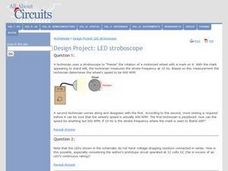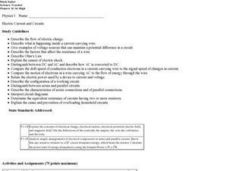Curated OER
BJT Amplifier Troubleshooting
In this electrical circuit worksheet, learners answer a series of 11 open-ended questions about BJT amplifiers and how to troubleshoot these circuits. This worksheet is printable and the answers are revealed online.
Curated OER
Sum of Products and Product of Sums Expression
In this electrical circuit learning exercise, learners answer a series of 21 questions about sum of product and product of sum, and Boolean expression for a logic circuit. They design and build a circuit board using PC-board relays...
Curated OER
Karnaugh Mapping
In this electrical circuit learning exercise, students answer a series of 17 questions using a Karnaugh map to generate a Boolean expression, and identify logic gates and functions. This learning exercise is printable and the answers are...
Curated OER
Design Project: DC Voltage Regulator
In this electrical worksheet, students draw a schematic design and build a circuit board to grasp the understanding of DC circuits before answering a series of 5 open-ended questions. There are no schematics available for the design or...
Curated OER
IGFET amplifiers
In this electronics learning exercise, students draw a schematic design and build a circuit board to grasp the understanding of IGFET amplifiers before answering a series of 2 open-ended questions with schematics. This learning exercise...
Curated OER
Impedance Matching with Transformers
In this electrical circuit worksheet, students answer a series of 19 questions by analyzing schematics dealing with the transformers. Students will determine the amount of impedance to various scenarios.
Curated OER
Conventional Transistor Overview and Special Transistors
In this electrical circuit worksheet, students develop an understanding of micro-controllers and then answer a series of 13 open-ended questions about transistors that include analyzing schematics. This worksheet is printable and the...
Curated OER
Pulse-Width Modulation Signal Generator
In this electrical worksheet, students answer a series of 6 open-ended questions about pulse-width signal generators. This worksheet is printable and the answers are revealed online.
Curated OER
Digital Codes
In this electrical circuit activity, students answer a series of 12 open-ended questions about various types of digital codes. This activity is printable and the answers are revealed online.
Curated OER
Basic Oscilloscope Operation
In this electrical worksheet, students answer a series of 25 questions about the use and understanding of an oscilloscope used by electrical technicians. This worksheet is printable and the answers are revealed on-line.
Curated OER
What's a Resistor?
Students determine what a resistor does as they construct parallel circuits. In this circuitry lesson, students experiment with batteries, alligator clips, a resistor and a three-way switch to find out what a resistor does. They continue...
Curated OER
Design Project: LED Stroboscope
In this physics worksheet, students design and build an electrical circuit using LED as a light source. They complete 2 short answer questions about their design.
Curated OER
TE Activity: Ohm's Law 2
High schoolers study Ohm's Law 2 after completing an activity about Ohm's Law 1. They determine how long it takes to charge a battery. They examine if it is better to use batteries in series or parallel circuits.
Curated OER
2010 Electricity
In this electricity worksheet, students determine if the circuits shown are parallel or series, calculate the voltage, and the power used by the light bulbs. This worksheet has 11 problems to solve.
PBS
Hidden Alarm
It's time! The fourth lesson in a five-part series has teams of scholars build a circuit for an alarm. A switch lets them turn the alarm on and off and allows them to hide the alarm—just as long as they don't hide it in the classroom!
CK-12 Foundation
Flashlight
In a simple circuit, does electricity start instantly? A simulation encourages thinking about the flow of electrons at a microscopic level. Pupils control the voltage, resistance, and switch in order to observe the change in both ideal...
PHET
Capacitor Lab
The first capacitor was a Leyden jar, invented in 1745. Physics scholars explore capacitors in an engaging simulation. They may view one or set up circuits which contain two to three either in series or parallel. Other views include...
CK-12 Foundation
Galvanometer
In 1820, Hans Christian Orstead discovered the link between electricity and magnetism, which allows us to measure current and voltage. The simulation allows scholars to observe the inner workings of an ammeter and voltmeter as they...
CK-12 Foundation
Flashing Neon Light
How does a neon light work and does it actually contain the gas neon? An enlightening simulation encourages pupils to play with circuits and neon lights. They control the capacitance, resistance, and color of the bulb, and the simulation...
Curated OER
Resistance In Series And Parallel Circuits
Students investigate electric circuits. For this electricity lesson, students observe illumination in a series and parallel circuits. They predict and calculate the resistance in each type of circuit using a voltmeter.
Curated OER
The Physics of Electricity: Real or Magic?
Eighth graders participate in various demonstrations on electricity. In this physics lesson, 8th graders explore static and current electricity. They apply concepts to real world situations.
Curated OER
Electric Current and Circuits
Compare the drift speed of conduction electrons in a current-carrying wire to the signal speed of changes in current. They also distinguish between DC and AC and describe how AC is converted to DC.
Curated OER
Basic Electric Circuits
Students calculate the resistance across a bank of resistors in a series, parallel and combined circuit. Using new vocabulary words, they define and describe them in a scientific manner. After stating Ohm's Law, they solve electrical...
Curated OER
Simple Circuits
Young scholars investigate how series and parallel circuits work. In this physics lesson, students build their own simple circuits and compare their characteristics. They explain the importance of circuit breakers in household circuits.























